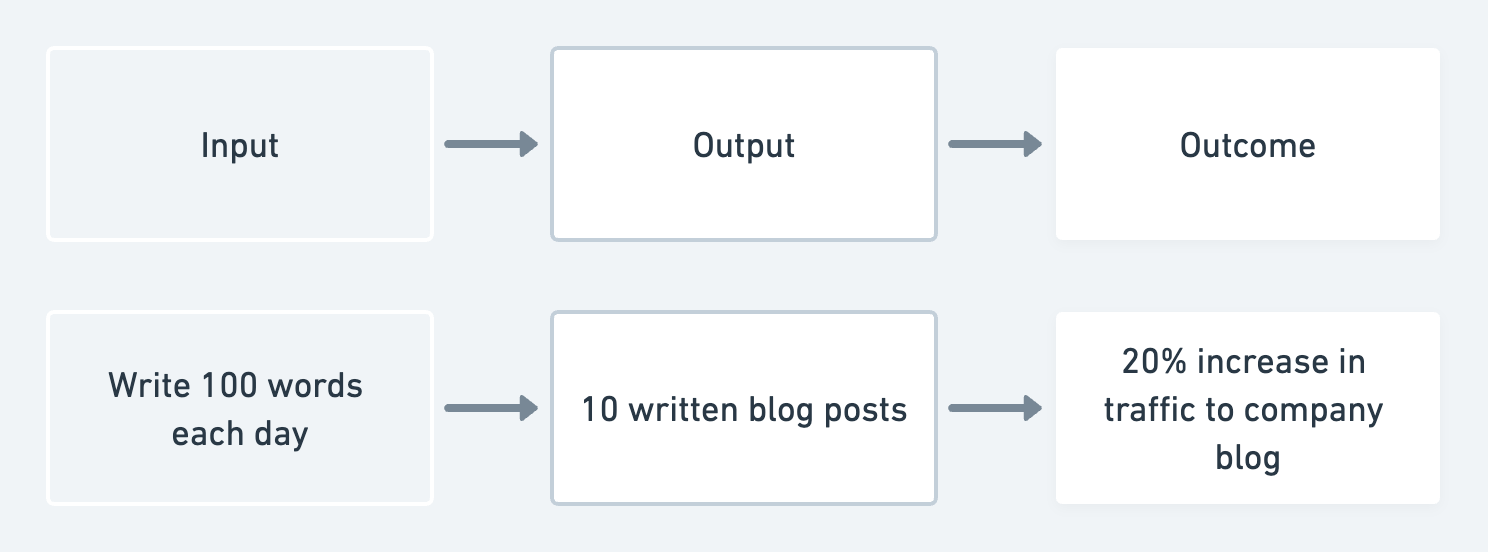The Complete Guide To OKR Inputs
In this guide, we’ll help you get a better understanding of OKR inputs, what they are and how you should use them when working with the OKR framework.

Lasse Ravn
Last updated on January 16th, 2023

What are inputs in OKR?
OKR stands for Objectives & Key Results so where do inputs come from and how do they fit in?
If you’ve worked a little with OKRs, you probably know that OKRs should focus on outcomes and not outputs. To give you an idea of the differences, see the image below:

How are OKR inputs different from outputs and outcomes?
Inputs are things that describe the actions we take, sometimes on a daily basis, to get our outputs.
They’re also what we ultimately believe will bring us closer to our desired outcome. You might also have heard the term initiatives (if not, then read about them here), so know that inputs and initiatives are very closely related and often interchangeable.
Now take the example above. We’ve set one of our key results to be that we want to: "Improve the amount of traffic to our company blog by 20%".
One of the ways we believe we can achieve that is by writing 10 quality blog posts about something that interests our customers.
To get to that output, and to maintain momentum during the OKR cycle, we’ve defined what small action it would require from us, on an ongoing basis, to produce the output we’re looking for, and to achieve our outcome ultimately.
Focus on tangible actions
Writing 100 words each day is a lot more tangible and easy to digest than increasing traffic by 20%.
The goal here is to get from something very ambitious, which frankly, might seem scary to some people, to something very easily achievable.
But there’s one crucial aspect here! If you’re a team lead or a manager, you should never define inputs for your team (read more below).
When you should use inputs with your OKRs
Admittedly, plenty of OKRs can’t really benefit from their owner describing input actions.
But what they can benefit from is having the owner of the OKR think about what it might take to reach the desired outcome.
Operational, repeatable tasks
There’s no doubt that inputs are best used with OKRs that require repeatable actions from you or the team.
It might be posting things on social media
It might be interviewing customers
It might be sending out emails
These are all things that, when done on a consistent basis, can achieve great results. So think about OKR inputs as the things that will hold you accountable for doing the work that you’ve defined that needs to be done.
The danger of micromanagement
One very important aspect of OKR inputs is that they should not be defined by a person not owning the OKR.
If you have a manager who’s defining inputs, you basically have a micromanaging manager.
If you own the OKR, you’re the one responsible for achieving the outcomes and therefore also the one who should define the inputs.
The main reason is that there are many ways to achieve a key result. Your manager might have an idea of one, but if that person thinks that’s the only way to solve it, then they’re likely micromanaging you and not trusting you to come up with solutions yourself.
If you’re interested in reading more about delegating things to team members, read this post on how to delegate OKRs.
How to come up with OKR inputs
Once you’ve begun planning a new OKR cycle, and you’ve defined your key results, you should start thinking about the initiatives and inputs you’ll work on.
Let’s say that I had a key result that was: “Increase avg. engagement rate by 10% on Instagram posts”.
My first idea would be to test different formats and creatives and see which would create engagement.
So I define one of my inputs as: “Test 1 new creative each week on Instagram and take note of engagement”.
By doing so, I know that I’ll at least have some insights into what works. From there, I can double down on the winning creatives and hopefully realize my key result.
How to track your OKR input tasks
It’s a good idea to track your input tasks in the same place as you store your key results. This way, you can always link the two together.
By doing that, you make it much easier to back in 6 months and see the inputs you created to achieve your key result.
This will not only make it easier for yourself, but you will also help your teammates in their efforts to create valuable OKR input tasks.
If you’re already using a system to track OKRs, then make sure you know how to score them. If not, then we’ve created a template for tracking your OKRs.